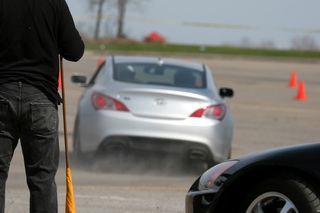 It can be a daunting prospect. First, motorsport is inherently dangerous and no one wants to put their life in danger. Second is the start up cost. Motorsport is typically a very, very expensive hobby, but it doesn't have to be.
It can be a daunting prospect. First, motorsport is inherently dangerous and no one wants to put their life in danger. Second is the start up cost. Motorsport is typically a very, very expensive hobby, but it doesn't have to be.Getting Started in Motorsport – A Beginners Guide to Autoslalom
Have you ever had an interest in participating in motorsport?
Maybe you always had the childhood dream of being a “race car driver” but never took that first step. Maybe you've just started watching the top tiered racing series on television and thought you'd like to try your hand at it. Maybe your a top notch gamer and think your fast.... With more than ten years of competition and hundreds of events, at a couple of different levels of amateur motorsport, I am regularly asked how does one go about getting involved in motorsport....
 It can be a daunting prospect. First, motorsport is inherently dangerous and no one wants to put their life in danger. Second is the start up cost. Motorsport is typically a very, very expensive hobby, but it doesn't have to be.
It can be a daunting prospect. First, motorsport is inherently dangerous and no one wants to put their life in danger. Second is the start up cost. Motorsport is typically a very, very expensive hobby, but it doesn't have to be.
It really isn't as daunting as it first appears.... People are usually very surprised to find out how easy and cheap it can be to start a life long passion, an adrenaline fix that can rival the best of them. Best of all, it's legal!
All you really need to get started in motorsport is a car that is good mechanical shape, a helmet (and sometimes clubs even provide these for those that don't want to initially make the $100 investment), $25-40 and a free Saturday or Sunday.
One of the most accessible forms of organized amateur motorsport is Autoslalom. Autoslalom (also known as Solo2, autocross or just slalom) is the easiest and probably best way to get involved in motorsport. Autoslalom, to some, is a stepping stone to move up the sedan ladder, to others it is a sport all in it's own. The saying goes, “If Solo 2 (Autoslalom) were any easier, it would be called road racing!”. That statement could be true!
Autoslalom
First lets learn what Solo2 or Autoslalom is all about. Autoslalom is about people. 50 to 100 eager men and woman of all age groups that are licensed to drive and their rides (ranging from beat up Honda Civics and Mazda Miatas, to Porsche 911 and C6 Corvettes or even your family Taurus) show up between 7:30 and 9am to prepare for a day of fun.
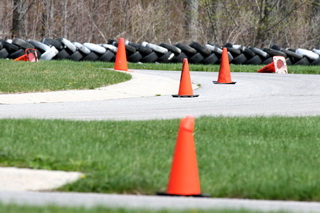 In Ontario Autoslalom events are hosted by Canadian Auto Sports Clubs – Ontario Region (CASC-OR) affiliated clubs. Clubs based from Ottawa, Kingston, Peterborough, Oshawa, Toronto, Mississauga, London and St. Catherines all host Autoslalom events through the short Ontario summers. You can look for a list of clubs at http://casc.on.ca to find the club that hosts events closest to you.
In Ontario Autoslalom events are hosted by Canadian Auto Sports Clubs – Ontario Region (CASC-OR) affiliated clubs. Clubs based from Ottawa, Kingston, Peterborough, Oshawa, Toronto, Mississauga, London and St. Catherines all host Autoslalom events through the short Ontario summers. You can look for a list of clubs at http://casc.on.ca to find the club that hosts events closest to you.
Events usually take place in large parking lots, but they also take place on race tracks, large skid pads and airport strips or any other large paved or concrete surface. A course is set up using orange traffic pylons that snakes it's way around the parking lot. It has a start box where you line up and when told to go, you break a timing beam. You navigate through the cones as fast as you can without hitting any of those pesky orange things (they are a two second time penalty for each cone displaced or knocked down) back to a stop box where you trigger another timing beam.
Cars are typically classed together by performance potential or modifications and the quickest time in each class is the winner. Every other competitor in that class is then scored based on the fastest person's time. In some events they use a scoring system called pax to group every car into one group and compared based on an indexing number that is applied to each competitors fastest time.
There are a couple of different levels of competition. First there are the club events. They take place in the hosting clubs lot and are laid back fun events with anywhere for 10-100 competitors. The Provincial Series consists of a series of events that take place across Ontario hosted by some of the same clubs that host club level events. Finally there is the National and International levels. A national event is held once a year in Canada. If your ambitious, you can make a trip across the border to run some SCCA events down in the US.
Car Preparation
Car preparation usually starts at home the day before. It is very important that the key components of the vehicle are well maintained. The brakes should be in perfect working order with more than 50% brake pads left. The brake pedal should be firm and should not move while administering a 15 second brake pedal test (press down on the brake with the car running and hold it for 15 seconds, if the brake pedal falls towards the floor during the 15 seconds there could be a leak in your breaking system somewhere).
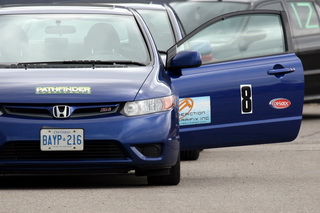
Check the brake fluid in the reservoir while checking your braking system. If the fluid is murky and brownish, it's time for a brake fluid flush. The best time to do this is when you are having your brakes serviced and the level of the brake fluid can be used as an indicator of brake material wear.
You should go through the car and make sure all of the trash and personal belongings have been removed from the car. The last thing you need is an empty drink bottle to become dislodged from under the drivers seat under braking and end up under your feet. Same with the trunk or hatch, make sure all the loose articles have been removed. You can remove your spare tire and jack at the event to reduce some weight a bit, but don't leave them at home as you may need them on the way to or from the event. Remove the floor mats and anything hanging from inside or outside the vehicle.
Tires
Tires must be in good shape as well. There should not be any defects in the tires and there should be no cord showing, anywhere. Lots of more serious competitors will have a second set of rims with specific tires mounted just to compete. There are hundreds of different options out there and most top competitors have competition tires or 'R' compounds to compete on. Full race slicks are not allowed unless they are on a purpose built machine and proper racing safety gear is used.
If you are using street tires, visit your local gas station and inflate your street tires to 40-44 pounds or to the maximum stated on the sidewall of the tire if lower than 44 pounds. Tires get abused and an under inflated tire will have excessive wear on the other edge of the tire and tires have been know to break the bead and come right off the rim under heavy loads. Bring along a tire pressure gauge and keep the pressures in the 40-44 pound range but they can be adjusted by observing how much tire roll over is taking place. If there is a lot of rollover, more air is needed....
Check your oil!!!!! No, check it again and check it regularly throughout the event if you are not completely in-sync with your machine. Low oil and heavy corning loads lead to spun bearings and expensive repairs, so check your oil again.... A clean air filter can do wonders when it comes to making power as sometimes is a new fuel filter. If they are more than four or five years old, replace them.
Suspension
Pull on all your wheels, top and sides, pull hard to rock the car back and forth sideways. There should be no play in anything. Any clunking or free play should be looked after, ball joints and tie rod ends take a lot of abuse. Suspension failure can lead to other damage as well.
You typically shouldn't need more than a quarter tank of gas, but any less may cause fuel depravation and more than a half tank is just throwing around extra weight, so about three eights of a tank is ideal. I usually manage my weekly driving to show up with just the right amount.
Relax
Don't stress too much about things. Have your vehicle ready the day before and the morning can be stress free. If you can pack everything you need into the car the night before, do so, if not have everything ready so it can be easily packed.
Event Day
There are a few things that you should bring to every event. You may not need them, but when you do need them you'll have them. Oil, bring a spare litre of engine oil with you. Sunscreen, hey if it's sunny out you will need it, trust me. Rain gear, always bring at least an umbrella to keep the upper half of your body dry and a tarp to throw all your loose stuff under when it does start to rain. Water, you get thirsty throughout the day and remember for every cup of coffee or other caffeinated beverage you consume you will need twice the volume of water to replenish the lost fluids.
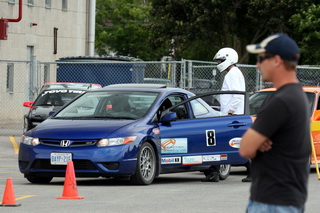 Lunch, some clubs include lunch, most do not. Tire pressure gauge to check tire pressures throughout the day. A portable air compressor or air pig so if you need air at the event, you've got it. A change of clothes and common tools, I always bring a bag with any video gear, a change of clothes, race gear and a few tools that are commonly needed. Make sure if your suspension is adjustable that you have the adjustment tools handy.
Lunch, some clubs include lunch, most do not. Tire pressure gauge to check tire pressures throughout the day. A portable air compressor or air pig so if you need air at the event, you've got it. A change of clothes and common tools, I always bring a bag with any video gear, a change of clothes, race gear and a few tools that are commonly needed. Make sure if your suspension is adjustable that you have the adjustment tools handy.
Dress accordingly, it may be cool in the mornings and hot in the afternoon so make sure you have clothes to cover both extremes. Closed shoes are mandatory, no sandals or other open toe shoes. A folding chair may be a good idea. There are sometimes lengthly delays or long waits between runs and having someplace to sit down is always nice.
If you are bring tires to change at the event, make sure you have a jack, spare lug nuts, a tire iron and it makes things easier if you have a cordless impact gun and socket. A torque wrench is also a must to ensure the wheels are properly fastened to the vehicle. This is much more important than it seems as many times I have had wheels that were not properly torqued down come loose during the day.
Show up early. You don't have to be the first one there, but don't show up right at the time registration is closing. Keep and open mind! See all the other competitors and the rituals that they go through. I have very specific things I do in the morning, when I have the time, and those things are key to having the focus to compete well.
Course walks are very important. The great thing about Autoslalom is every single event you go to, the course is different. It's not just about being fast, but learning the course quick enough to be fast. As soon as the club has finished setting up the course and you have your car ready, make sure you are registered for the event then start walking.
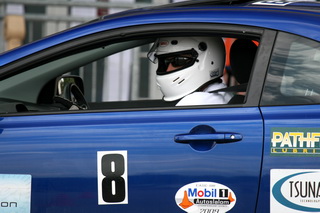 Although you may not be going as fast walking as you would in the car you can get an idea of where you need to go and that's the most important thing. Hook up with someone walking who looks like they know what they are doing. Most of the competitors out there are more than willing to give advise on what you should do and where you should be on the course. If you can close your eyes and navigate your way through the cones before the first runs, you're ready to go!
Although you may not be going as fast walking as you would in the car you can get an idea of where you need to go and that's the most important thing. Hook up with someone walking who looks like they know what they are doing. Most of the competitors out there are more than willing to give advise on what you should do and where you should be on the course. If you can close your eyes and navigate your way through the cones before the first runs, you're ready to go!
There is one more thing you need to know before you turn the key for the first time. No matter what your background in driving, check your ego at the door. If this is your first time you are going to get beat unless you are the true next big thing... Dozens upon dozens of first timers have shown up, cocky and boasting away, only to have been soundly beaten. They go away, never to be seen again. Go out with the frame of mind to have fun and not be competitive, you'll enjoy yourself a lot more during you first few events.
The rest is the fun part. Typical runs last 40 to 70 seconds and can be the most intense you'll ever experience. At most events each competitor will get four to eight runs per day and usually have to help out by doing a marshaling stint between runs, picking up cones and calling them in to the timing team.
If you just come out to watch at an event at first, the best thing you can do is to sign the waiver and ask some competitors if they mind a passenger. Most competitors early in the day don't mind passengers at all. It can be a lot of fun riding along, it passes the time between runs and can be a learning tool to see what other drivers do and how they react. Again if you don't have a helmet, most clubs have loaners available.
Since competitors only typically get 5 minutes of actual seat time, it can sometimes seem a little drawn out but the social aspect of the event is as important as the competition. Lots of people with the same mind set from all kinds of different backgrounds enjoy this sport. Get to know some people, you could be making life long friends....
The best place to start is CASC-OR sanctioned Autoslalom School. It usually takes place in late April and is put together by one of the CASC-OR clubs or the CASC-OR Autoslalom division, usually somewhere in the GTA. Some clubs host there own school or open session style days for their members to get people started. All are a great place to start, I did.
If you really enjoy yourself you can move from the club level to the Provincial level or even the National level of the sport. Travelling across the Province or half way across the country to sample events and competition from other clubs or regions can be fulfilling and everyone in the sport is friendly, wherever you go in this great country.
Help Out
 You may eventually want to make a difference at events or behind the scenes by volunteering to one of the clubs to help out where you can. They will appreciate it most of the time, it can be rewarding and there can sometimes even be some perks.
You may eventually want to make a difference at events or behind the scenes by volunteering to one of the clubs to help out where you can. They will appreciate it most of the time, it can be rewarding and there can sometimes even be some perks.
The most important thing though is to have fun! If you have any questions or need any help, ask someone. Most people are more than willing to help someone out, assuming your not in their class......(just kidding). Stick around until the very end and take advantage of “fun runs” which happen at most events for a half hour or so. These are great fun with no pressure to compete.
When the day is over make sure you pick up all your garbage and make your spot better than it was hen you arrived. Lots are extremely hard to come by and the hosting club would hate to loose the lot because of garbage or at the very least would take the club longer to clean up. Help pick up the cones. It makes it easier for the club if they just have to drive around to load piles of cones in their vehicle and if each competitor were to stack ten cones, it would make quick work of it.
If you get a further need for speed, the next step is SoloSprint. SoloSprint (also known as Time Attach or Time Trial) where it is the car and driver against the clock on real race tracks, but more on that in the future....
The skills learned in this sport are directly transferable to your everyday driving. Knowing the exact limits of you vehicle will allow you to handle yourself better in life threatening situations on our roads. Autoslalom is a fast paced sport once your behind the wheel and allows you to get your adrenaline fix while honing a useful skill.
And remember when the day is over to drive responsibly to set an example for the rest of the drivers on our roads...
For more information and a list of clubs that host Autoslalom events in Ontario, refer to http://solo2.casc.on.ca. More information about the sport in general is available with a schedule of all events in Ontario.
Wes Tanney
Tanney Motorsport
The following are the series that Tanney Motorsport participate in;
CASC-OR
Autoslalom -CASC-OR
2009 Mobil 1 Autoslalom Championship Series
CASC-OR SoloSprint - 2009
Mobil 1 SoloSprint Championship Series
Canadian Autoslalom Championship - ASN
Canada FIA Canadian Autoslalom Championship
Canadian
SoloSprint Championship - ASN
Canada FIA Canadian SoloSprint Championship
HADA Autoslalom - HADA
Motorsport Club's Autoslalom Series
Tanney Motorsport’s sponsors included the following;
Tsunami
Technology Group Inc. – http://www.technology.ca/
Reaction
Grafix – http://www.reactiongrafix.com/
Pathfinder
Lubricants – http://www.daydistributing.ca/
GTA
Wheel & Tire Zone – http://www.wheelandtirezone.com/
CG-Lock Canada – http://www.cglockcanada.com/
This page was last updated on November 27th, 2011
![]()